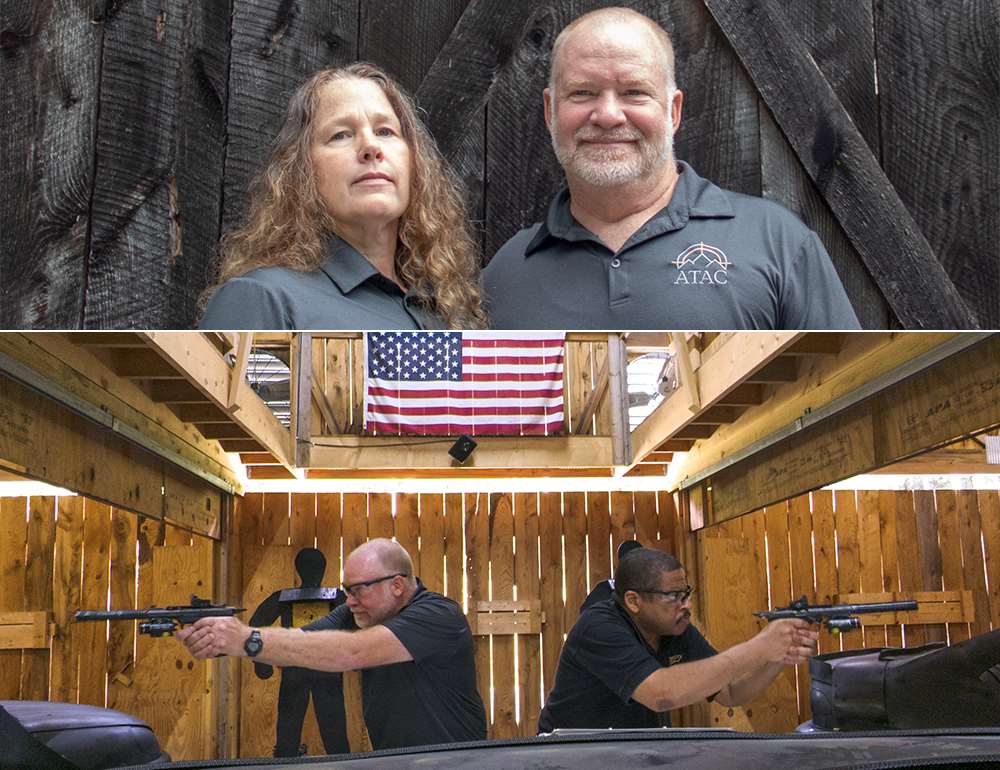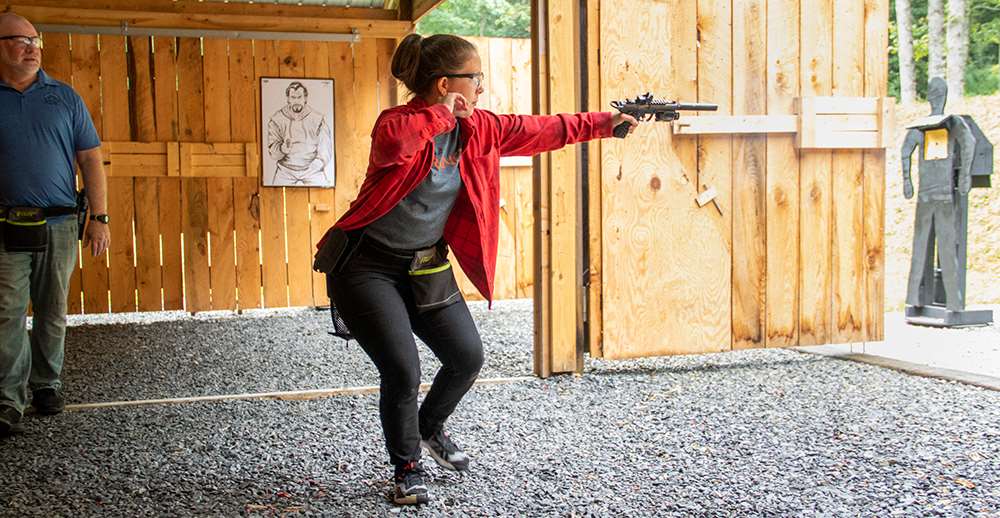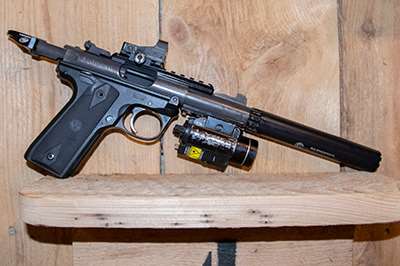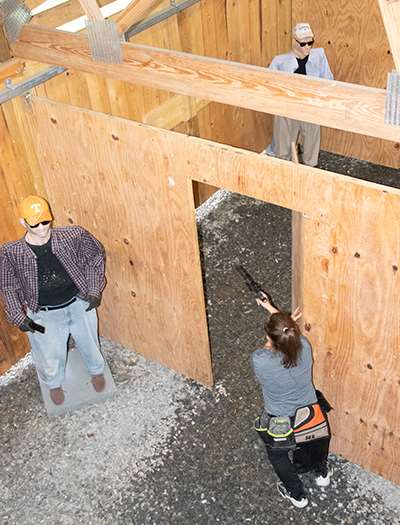
We—myself and two friends, Jen and Daniel—rolled up to Appalachian Tactical Acquisition Training, or ATAC, in a truck dusty from a winding gravel road. The drive from Virginia into Shady Valley, Tenn., was one of beautiful, towering trees, glimpses of a burbling creek chasing alongside us and a stunning rock archway over the road near the state line.
Now, we gazed at what seemed like a ramshackle farm on a back road with no mobile-phone coverage, feeling lost. We stepped out cautiously, but we were soon reassured by an ATAC sign we’d missed as we drove in.
We were greeted and brought around to the main building, where we saw that the seemingly rundown old place was actually a well-restored historic tobacco farm. We were brought into a comfortable sea-land-container building with air conditioning, restrooms, snacks and coffee.
The couple running this establishment, Travis and Ashley Worlock, are both ex-military and clearly very knowledgeable about guns, tactics and—perhaps somewhat unexpectedly—psychology. (They are also two of the nicest people I have ever had the pleasure to encounter.)
They parked us in camping chairs in front of a row of televisions and gave us a presentation on what to expect during our stay. Travis immediately said some pretty challenging things, and, as a staunch follow-the-rules type of gun-safety instructor, I found myself a little wary.
But everything Travis challenged us on ultimately makes sense in the context of defending your life. It should, since he and Ashley were both in the U.S. Army Special Operations’ Cultural Support Teams effort, in which women were trained to be the points of contact—providing medical aid and gathering information—for Afghan women and children as the troops conducted operations. These female soldiers needed to be both culturally and defensively tactical to fulfill the missions. Travis, a Green Beret, was responsible for training many of these women, and Ashley, a Psychological Operations officer, lived the role. As they retired from military service, they decided to train civilian defenders, with a particular focus on women and couples.
The need for excellent firearms training has risen as more Americans embrace their right to keep and bear arms. Incredibly, October 2023 marked the 51st month in a row in which adjusted background-check numbers exceeded one million, according to data from the National Shooting Sports Foundation (NSSF). And while those numbers don’t directly correlate to new gun owners or even to new gun purchases, they are an indicator of the increasing numbers of both. Other data provided by the NSSF points to the increasing diversity of gun owners, including black Americans buying at an estimated rate 58% greater in 2020 than 2019, and women making up about 40% of gun owners.

Firearms training has seen similar growth, and, as the audience becomes more diverse, the industry is slowly starting to see some changes in standard training norms as well. Women, for example—who are now a large portion of the demographic—often seek out women-specific training, like NRA’s Women on Target program, perhaps because their needs in training differ from the needs of the men lined up on either side of them.
More than 125,000 NRA instructors (you can find some near you at NRAinstructors.org) help new gun owners with the safe handling of firearms and the fundamentals of marksmanship every day. This is a great start, but if you picture the usual training course—a long line of people standing in the open, facing paper targets, shooting with an emphasis on marksmanship—you can see how it doesn’t represent what a real-life defensive situation might be like. The training is still valuable, of course, but more is needed to help people understand how to actually defend themselves and others.
The Worlocks clearly saw the need for a more comprehensive approach and have designed their training to fill in the gaps. Here are just a few of the takeaways from their training.
1. Who is with you?
Private instruction is one outstanding aspect of ATAC’s training. You train with your own group—ideally just two people, but they can accommodate up to four. One obvious benefit is that you get a high round count and repetition rate; for example, in the room-clearing scenarios, we were able to practice advancing into the room 75 times each. Furthermore, those being trained can’t help but feel more comfortable than they likely would with strangers on either side of them. The small group sizes also allow you to get the personalized attention you need to truly step up your defensive skills, which really varies from person to person; plus, it lets you practice communicating with those who might be with you in a real defensive situation.

It pays to practice such communication; in fact, I’ve often found it to be the most-difficult part of training on the rare occasions it’s incorporated at all. This was especially true in ATAC’s vehicle-defense training, as I attempted to move from vehicle to vehicle, shooting at threats, but also tried to keep track of where my partner was and to ensure they didn’t get in front of my muzzle. Private instruction allows couples in particular to improve their ability to work together (something most need to work on even without factoring in adrenaline). In a real emergency, if you don’t communicate, you could end up hurting those you seek to protect, and the skill is more complicated than you might think, especially under stress.
2. Can you deter the threat?
Ashley and Travis emphasize constantly that your goal as an armed citizen should not be engaging the threat; rather, your goal should be to get home to your family—that is, to avoid being shot.
Thus, they start their live-fire training with shooting while moving to cover. They teach you to make yourself a hard target by using cover effectively and by getting smaller while moving. To increase psychological effects, they have you use whichever hand is closest to the assailant to fire shots at them. The mental repercussions of the laser, the muzzle flash and the firing report, along with the blinding effect of the flashlight, should not be discounted. Together, these should significantly dampen any assailant’s desire to advance. Using the hand closest to the assailant also helps you avoid sweeping yourself with your muzzle; plus, by the time the training is over, you’ve learned to operate your firearm easily with either hand.
3. Where is the threat?
In a real-life defensive scenario, you might face one threat whom you can see clearly, but it’s just as likely, or even more likely, that you might face multiple assailants, all around you, possibly in dim light. ATAC therefore has multiple 360-degree ranges. This made me nervous at first, given my own comfort with that straight firing-line norm. I’ve been in shoot-houses before, too, notably during Gunsite’s excellent Team Tactics course, but much more rarely and only with simunitions.
Using live ammunition in a 360-degree range, sometimes with others around, can really make you hesitate, as indeed it should. But it is possible to set this up in a safe manner, as they have at ATAC, with the range being shielded on all sides. Rounds from the .22 LR-caliber suppressed pistols they use for training cannot penetrate the metal shielding, so if you’re outside the enclosed range while the trainer and trainee are inside, you’re safe. As for having multiple participants in a 360-degree environment, as they do in the vehicle training, they carefully choreograph who will be where and when, shooting in opposite directions, and they carefully monitor the participants; in fact, the instructor is right behind your shoulder throughout.
The benefits are enormous. Rather than training in what Travis calls a “cone of complacency,” you’re in an environment where a realistic-looking threat might be anywhere. You are also practicing moving to cover, practicing how many rounds you have versus how many threats exist and practicing sweeping the room, all while having to consider where other innocent people are positioned. As Ashley put it, “You live in a 360-degree environment; why not train in one?”

4. Can you hit the target?
One unusual stance the Worlocks take is on the use of a lower-caliber firearm (specifically, Ruger Mark IV 22/45 Tactical pistols with SilencerCo’s Warlock 22 suppressors).
Most firearms trainers—and other experts—will tell you to use the largest caliber you can manage. Some training facilities will not even allow you to use anything less than 9 mm to participate.
But there are significant training benefits to using suppressed .22 LRs. You can shoot them all day without soreness or injury, for one thing. You can also actually hear the trainer, even while firing, thanks to the significantly lower-decibel report. This makes learning easier and makes the training safer. To explain how the training makes you effective with any caliber, the Worlocks use the analogy of learning to drive a car: “Imagine if someone said you have to practice driving with the exact type of automobile you’ll use and that’s the only vehicle you can drive from then on,” said Travis. “Every vehicle has a steering wheel, a transmission, a brake and gas. You can train in a Pinto and drive a Ferrari. The same is true for guns.”
But it’s also a defensive consideration. The Worlocks emphasize the deterrent effect of any gun—carrying a .22, especially with today’s defensive .22 LR ammunition, is a significantly better option than carrying nothing. As noted in the first section, an assailant will not be very likely to know what caliber your gun is—they’ll only know there is a gun aimed at them. Furthermore, the Worlocks provide videos and statistics about how often defenders miss when dealing with adrenaline and higher recoil, including one startling example of a police officer firing every round he had at a near (and advancing) threat … and missing every time. Deterrence is the first goal, but effectiveness is a close second. The ability to hit the target while under stress is, indeed, more important than caliber.

For some defenders, of course, especially smaller or older people, .22 LR is the only option they can manage anyway. Does that mean you should switch your 9 mm to a .22 LR? Not necessarily, but perhaps you should time just how fast you can get accurate follow-up shots on a moving target under significant stress, then try it with a lower caliber to see the difference.
The use of sights, optics, flashlights and lasers is another consideration for whether you can actually hit the target. In defensive scenarios, your standard iron sights might not even come into play, as they require time to line up correctly. People tend to point and shoot under stress—this is another factor in low defensive-hit rates. Red-dots may be better—but only if you’ve taken the time to really train with them, as those not familiar with them may spend more time finding the dot than they should in a defensive scenario. A laser lets you keep your eyes on the threat itself and is easy to find. In low-light scenarios in particular, the Streamlight TLR-2 flashlight/lasers mounted on ATAC’s pistols made all the difference. I was fully sold on getting a similar setup for my defensive gun.
5. Should you shoot?
For many programs, the decision-making process of whether to actually shoot at what appears to be a lethal threat represents a small portion of the training. In ATAC, too, the threat was at first assumed to be valid; however, the training incorporated more and more realistic shoot/don’t-shoot scenarios as you went along, with mannequins dressed in a variety of ways, holding objects that could be guns but sometimes weren’t (and which were swapped out from scenario to scenario, so you never knew).
Travis and Ashley really drive home the difficulty of defensive decision-making in “capstone” scenarios where you have no idea what kind of scene you’re going into and where your brain becomes easily muddled by noise, clutter, dim lighting and other stresses. I won’t go too deeply into the capstones, as that defeats the point of them, but suffice to say, they will sober you. I’m still not actually sure whether one decision I made was the right one or not, yet I believe the doubt itself is valuable. Perhaps this humility, which spurs reflection and continued preparation, is the greatest tactical advantage of all.


































